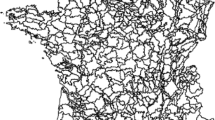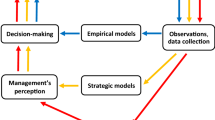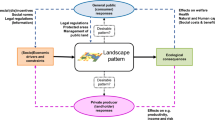Abstract
The science of ecology is undergoing many important shifts in emphasis and perspective which have important implications for its role in designing sustainable farming systems. In particular, a shift has occurred from the equilibrium paradigm to one which recognises the dynamic, non-equilibrium nature of ecosystems. Allied to this is the recognition that ecosystems can occur in any one of a number of alternative stable states, depending on the disturbance and management history. An increased emphasis on spatial patchiness in ecosystems has also emerged as appropriate tools have emerged to analyse spatial mosaics. These features have led to a recognition that considerable uncertainty is associated with the outcome of any particular ecosystem modification; hence predictive capacity is also low. Recent considerations of the interrelation between biodiversity and ecosystem function have also explored the questions of how many species need to be in a system to fulfil certain functions and confer resilience. We identify a set of steps that are required for the development of an agricultural system based on mimicking natural ecosystems. Central to this is identifying (1) the functions which are currently suboptimal in the agricultural system, and (2) the species which have key functional roles in the natural system, and then reaching decisions as to the array of species needed to confer system function and resilience.
Similar content being viewed by others
References
Aarssen LW (1997) High productivity in grassland ecosystems: effected by species diversity or productive species? Oikos 80: 183–184
Baskin Y (1994) Ecologists dare to ask: how much does diversity matter? Science 264: 202–203
Baskin Y (1997) The Work of Nature: How the Diversity of Life Sustains Us. Island Press, Washington, DC
Botkin DB (1990) Discordant Harmonies. A New Ecology for the Twenty-first Century. Oxford University Press, Oxford
Chapin FS, Walker BH, Hobbs RJ, Hooper DU, Lawton JH, Sala OE and Tilman D (1997) Biotic control over the functioning of ecosystems. Science 277: 500–504
Christensen NL (1988) Succession and natural disturbance: paradigms, problems, and preservation of natural ecosystems. In: Agee JK and Johnson DR (eds) Ecosystem Management for Parks and Wilderness, pp 62–86. University of Washington Press, Seattle
Daily GC (ed) (1997) Nature's Services: Societal Dependence on Natural Ecosystems. Island Press, Washington, DC
Fiedler PL, White PS and Leidy RA (1997) The paradigm shift in ecology and its implications for conservation. In: Pickett STA, Ostfeld RS, Shachak M and Likens GE (eds) The Ecological Basis of Conservation: Heterogeneity, Ecosystems and Biodiversity, pp 83–92. Chapman and Hall, New York
Graham JD and Wiener JB (eds) (1995) Risk vs. Risk: Tradeoffs in Protecting Health and the Environment. Harvard University Press, Harvard, Massachusetts
Hobbs RJ (1992) Is biodiversity important of ecosystem functioning? Implications for research and management. In: Hobbs RJ (ed) Biodiversity in Mediterranean Ecosystems in Australia, pp 211–229. Surrey Beatty and Sons, Chipping Norton, NSW
Hobbs RJ (1994) Dynamics of vegetation mosaics: can we predict responses to global change? Écoscience 1: 346–356
Hobbs RJ (1997) Future landscapes and the future of landscape ecology. Landscape and Urban Planning 37: 1–9
Hobbs RJ (1998) Managing ecological systems and processes. In: Peterson D and Parker VT (eds) Scale Issues in Ecology. Columbia University Press, New York
Hobbs RJ, Groves RH, Hopper SD, Lambeck RJ, Lamont BB, Lavorel S, Main AR, Majer JD and Saunders DA (1995) Function of biodiversity in the mediterranean-type ecosystems of southwestern Australia. In: Davis GW and Richardson DM (eds) Mediterranean-type Ecosystems: The Function of Biodiversity, pp 233–284. Springer, New York
Hobbs RJ and Mooney HA (1995) Spatial and temporal variability in California annual grassland: results from a long-term study. Journal of Vegetation Science 6: 43–57
Huston MA (1997) Hidden treatments in ecological experiments: re-evaluating the ecosystem function of biodiversity. Oecologia 110: 449–460
Jones CG, Lawton J and Shackak M (1994) Organisms as ecosystem engineers. Oikos 69: 373–386
Jones CG and Lawton JH (eds) (1995) Linking Species and Ecosystems. Chapman and Hall, New York
Jordan CF (1995) Conservation: Replacing Quantity with Quality as a Goal for Global Management. John Wiley and Sons, Chichester
Jordan WRI, Gilpin ME and Aber JD (1987) Restoration ecology: ecological restoration as a technique for basic research. In: Jordan WR, Gilpin ME and Aber JD (eds) Restoration Ecology: A Synthetic Approach to Ecological Research, pp 3–21. Cambridge University Press, Cambridge
Keddy PA (1989) Competition. Chapman and Hall, London
Keddy PA (1992) Assembly and response rules: two goals for predictive community ecology. Journal of Vegetation Science 3: 157–164
Levin SA (1989) Challenges in the development of a theory of community and ecosystem structure and function. In: Roughgarden J, May RM and Levin SA (eds) Perspectives in Ecological Theory, pp 242–255. Princeton University Press, Princeton
Main AR (1992) The role of diversity in ecosystem function: an overview. In: Hobbs RJ (ed) Biodiversity of Mediterranean Ecosystems in Australia, pp 77–93. Surrey Beatty and Sons, Chipping Norton, NSW
McDonnell MJ and Pickett STA (eds) (1993) Humans as Components of Ecosystems. The Ecology of Subtle Human Effects and Populated Areas. Springer Verlag, New York
Mills LS, Soulé ME and Doak DF (1993) The keystone species concept in ecology and conservation. BioScience 43: 219–224
Mooney HA, Cushman JH, Medina E, Sala OE and Schultze E-D (eds) (1996) Functional Roles of Biodiversity: A Global Perspective. John Wiley and Sons, Chichester
Naeem S, Håkansson K, Lawton JH, Crawley MJ and Thompson LJ (1996) Biodiversity and plant productivity in a model assemblage of plant species. Oikos 76: 259–264
Naeem S, Thompson LJ, Lawler SP, Lawton JH and Woodfin RM (1994) Declining biodiversity can alter the performance of ecosystems. Nature 368: 734–736
Naeem S, Thompson LJ, Lawler SP, Lawton JH and Woodfin RM (1995) Empirical evidence that declining species diversity may alter the performance of terrestrial ecosystems. Proceedings of the Royal Society of London B 347: 249–262
Noble IR and Slatyer RO (1980) The use of vital attributes to predict successional changes in plant communities subject to recurrent disturbances. Vegetatio 43: 5–21
Odum EP (1992) Great ideas in ecology for the 1990s. BioScience 42: 542–545
Ostfeld RS, Pickett STA, Shachak M and Likens GE (1997) Defining the scientific issues. In: Pickett STA, Ostfeld RS, Shachak M and Likens GE (eds) The Ecological Basis of Conservation: Heterogeneity, Ecosystems and Biodiversity, pp 3–10. Chapman and Hall, New York
Pahl-Wostl C (1995) The Dynamic Nature of Ecosystems. Chaos and Order Entwined. Wiley and Sons, Chichester
Paine RT (1995) A conversation on refining the concept of keystone species. Conservation Biology 9: 962–964
Peters RH (1991) A Critique for Ecology. Cambridge University Press, Cambridge
Pickett STA, Kolasa J and Jones CG (1994) Ecological Understanding: The Nature of Theory and the Theory of Nature. Academic Press, New York
Pickett STA and Ostfield RS (1995) The shifting paradigm in ecology. In: Knight RL and Bates SF (eds) A New Century for Natural Resources Management, pp 261–278. Island Press, Washington, DC
Pickett STA, Parker VT and Fiedler P (1992). The new paradigm in ecology: implications for conservation biology above the species level. In: Fielder P and Jain S (eds) Conservation Biology: The Theory and Practice of Nature Conservation, pp 65–88. Chapman and Hall: New York
Schulze E-D and Mooney HA (eds) (1993) Ecosystem Function of Biodiversity. Springer Verlag, Berlin
Shrader-Frechette KS and McCoy ED (1993) Method in Ecology. Strategies for Conservation. Cambridge University Press Cambridge
Simberloff D (1982) A succession of paradigms in ecology: essentialism to materialism and probabilism. In: Saarinen E (ed) Conceptual Issues in Ecology, pp 63–99. Reidel, Boston
Smith TM and Shugart HH (eds) (1996) Plant Functional Types. Cambridge University Press, Cambridge
Stone R (1995) Taking a new look at life through a functional lens. Science 269: 316–317
Tilman D and Downing JA (1994) Biodiversity and stability in grasslands. Nature 367: 363–365
Tilman D, Wedin D and Knops J (1996) Productivity and sustainability influenced by biodiversity in grassland ecosystems. Nature 379: 718–720
Turner MG and Gardner RH (eds) (1991) Quantative Methods in Landscape Ecology. The Analysis and Interpretation of Landscape Heterogeneity. Ecological Studies. Springer-Verlag, New York
Vitousek PM, Mooney HA, Lubchenco J and Melillo J (1997) Human domination of Earth's ecosystems. Science 277: 494–499
Walker BH (1992) Biodiversity and ecological redundancy. Conservation Biology 6: 18–23
Walker BH (1995) Conserving biological diversity through ecosystem resilience. Conservation Biology 9: 747–752
Weiher E and Keddy PA (1995) The assembly of experimental wetland plant communities. Oikos 73: 323–335
Woodward FI and Cramer W (1996) Plant functional types and climate change: introduction. Journal of Vegetation Science 7: 306–308
Author information
Authors and Affiliations
Corresponding author
Rights and permissions
About this article
Cite this article
Hobbs, R.J., Morton, S.R. Moving from descriptive to predictive ecology. Agroforestry Systems 45, 43–55 (1999). https://doi.org/10.1023/A:1006263503404
Issue Date:
DOI: https://doi.org/10.1023/A:1006263503404




